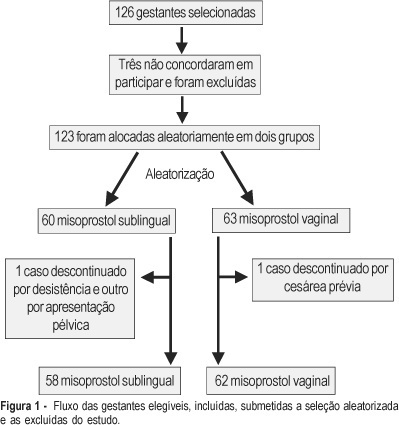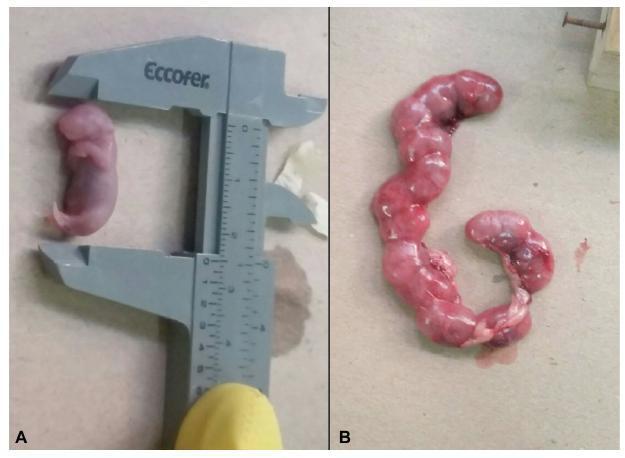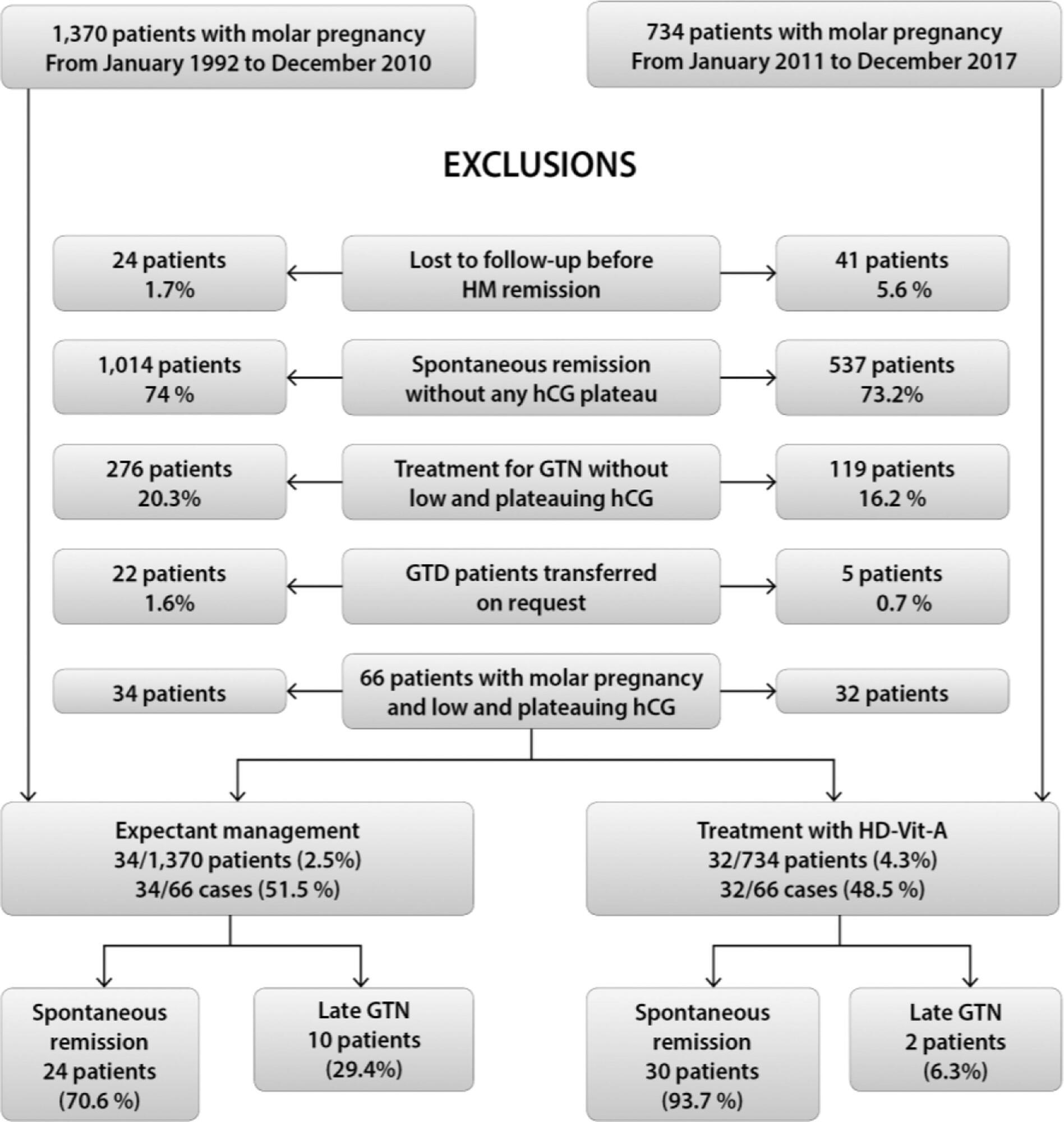Summary
Revista Brasileira de Ginecologia e Obstetrícia. 2005;27(1):24-31
DOI 10.1590/S0100-72032005000100006
PURPOSE: to compare the effectiveness and safety of sublingual misoprostol (25 µg) versus vaginal misoprostol (25 µg) (Prostokos®) for labor induction with gestational age > 37 weeks and unripe cervices. METHODS: a randomized controlled clinical trial was performed at the Maternidade Monteiro de Morais (CISAM-UPE), in Recife - PE, Brazil, from October 2003 to February 2004. One hundred and twenty-three women with gestational age > 37 weeks, Bishop score <8, not in labor and with medical indication for interruption of pregnancy were included in this study. The women received randomly 25 µg sublingual misoprostol or 25 µg vaginal misoprostol every 6 h, not exceeding eight doses. In order to evaluate the differences between the groups, means, standard deviations, Student's t-test, c² trend and Mann-Whitney test were used. The statistical significance was considered to be 5%. RESULTS: there were no significant differences between the number of women with vaginal delivery in the sublingual group as compared with the vaginal group (65.5 vs 75.8%, p<0.22), or in the interval of time between the induction onset and delivery (24 h and 42 min vs 20 h and 37 min respectively, p=0.11). The two groups, sublingual and vaginal, also did not differ as to the hyperstimulation syndrome (1.7 vs 3.2%, p=0.95), meconium incidence (5.2 vs 4.8%, p=0.74), Apgar score <7 at 5 min (3.4 vs 4.8%, p=0.98) and other adverse effects. CONCLUSION: twenty-five micrograms of sublingual misoprostol every six h presented the same effectiveness and safety as an equal vaginally administered dose of this substance. Sublingual misoprostol seems to be acceptable and is another option to be considered for labor induction.

Summary
Revista Brasileira de Ginecologia e Obstetrícia. 2015;37(1):24-29
DOI 10.1590/S0100-720320140005139
To verify the predictors of intravasation rate during hysteroscopy.
Prospective observational study (Canadian Task Force classification II-1). All cases (n=200 women; 22 to 86 years old) were treated in an operating room setting. Considering respective bag overfill to calculate water balance, we tested two multiple linear regression models: one for total intravasation (mL) and the other for absorption rate (mL.min-1). The predictors tested (independent variables) were energy (mono/bipolar), tube patency (with/without tubal ligation), hysterometry (cm), age≤50 years, body surface area (m2), surgical complexity (with/without myomectomy) and duration (min).
Mean intravasation was significantly higher when myomectomy was performed (442±616 versus 223±332 mL; p<0.01). In the proposed multiple linear regression models for total intravasation (adjusted R2=0.44; p<0.01), the only significant predictors were myomectomy and duration (p<0.01).In the proposed model for intravasation rate (R2=0.39; p<0.01), only myomectomy and hysterometry were significant predictors (p=0.02 and p<0.01, respectively).
Not only myomectomy but also hysterometry were significant predictors of intravasation rate during operative hysteroscopy.
Summary
Revista Brasileira de Ginecologia e Obstetrícia. 2006;28(1):24-31
DOI 10.1590/S0100-72032006000100005
PURPOSE: to verify the coverage and factors associated with Papanicolaou (Pap) testing in Londrina (PR), Brazil. METHODS: this is a cross-sectional study, carried out in 2004, in microareas of five Basic Health Units (BHU) of Londrina. One or two microareas from each BHU were selected and a list of all women aged 20-59 years resident in these places, was made through search in the Basic Attention Information System, the women being then visited and interviewed. Those with a Pap test in the last three years were considered as having an updated examination, and the remaining as delayed. The association of some factors with the examination situation was investigated. Data analysis was performed using Epi-Info 6.04d. RESULTS: Pap smear coverage among the 513 participants of the study was 80.7%, ranging from 71.5% to 88.4%. Delay in taking the test was higher (p<0.05) among women who worked only at home (22.4% as compared with 14.3% among those who worked outside), and among those who belonged to D/E social classes (24.9%) as compared to C (17.5%) and A/B (8.3%) classes. The proportion who ignored the next test date was higher (p<0.01) among those who had the last Papanicolaou testing at a BHU (14.7%), as compared to those who had been attended privately or by a health insurance company (5.8%). CONCLUSION: the coverage of Pap smear in the studied areas can be considered satisfactory, although there is a need of improving compliance with Pap test, mainly among women who are the poorest and who work only at home.
Summary
Revista Brasileira de Ginecologia e Obstetrícia. 2019;41(1):24-30
The aim of this study is to evaluate whether exposure to different environmental lighting conditions affects the reproductive parameters of pregnant mice and the development of their offspring.
Fifteen pregnant albino mice were divided into three groups: light/dark, light, and dark. The animalswere euthanized on day 18 of pregnancy following the Brazilian Good Practice Guide for Euthanasia of Animals.Maternal and fetal specimens weremeasured and collected for histological evaluation. Analysis of variance (ANOVA) test was used for comparison of the groups considering p ≤ 0.05 to be statistically significant.
There was no significant difference in the maternal variables between the three groups. Regarding fetal variables, significant differences were observed in the anthropometric measures between the groups exposed to different environmental lighting conditions, with the highest mean values in the light group. The histological evaluation showed the same structural pattern of the placenta in all groups, which was within the normal range. However, evaluation of the uterus revealed a discrete to moderate number of endometrial glands in the light/dark and light groups, which were poorly developed in most animals. In the fetuses, pulmonary analysis revealed morphological features consistent with the transition from the canalicular to the saccular phase in all groups.
Exposure to different environmental lighting conditions had no influence on the reproductive parameters of female mice, while the offspring of mothers exposed to light for 24 hours exhibited better morphometric features.

Summary
Revista Brasileira de Ginecologia e Obstetrícia. 2011;33(9):240-245
DOI 10.1590/S0100-72032011000900004
PURPOSE: To determine the accuracy of ultrasound in fetal weight estimation and to evaluate maternal and/or fetal factors that could interfere in the result. METHODS: This was a transverse prospective study, involving 106 patients, with 212 fetal weight evaluations, by two observers, within 24 h to delivery. The following parameters were measured: biparietal diameter, head circumference, abdominal circumference, and femoral length. Fetal weight was estimated using the Hadlock formula and the results were compared to birth weight. The maternal factors examined were: weight, BMI, and skin to uterus distance measured by ultrasound, and the fetal factors were: presentation, position, placental localization and thickness, fetal weight, and amniotic fluid index (AFI). RESULTS: There was good correlation between estimated fetal weight and birth weight (R=0.97). In 79.2% and in 92.4% of cases the estimated fetal weight was within 10% and 15% of birth weight, respectively. The only maternal factor that presented a positive correlation with percent error in the estimate of fetal weight was the skin to uterus distance (R³0.56). Fetal weight showed negative correlation with percent error (R>-0.36; p<0.001), with a significant tendency to overestimate fetal weight in the group of very low weight - <1000 g (p<0.05). The AFI showed a low negative correlation with percent error (R=-0.21; p<0.001) with no difference between AFI groups (p=0.516). CONCLUSION: Ultrasound presented good accuracy in the estimation of fetal weight. The error of weight estimate was directly proportional to the skin to uterus distance and inversely proportional to fetal weight. AFI did not interfere significantly in the ultrasound prediction of fetal weight.
Summary
Revista Brasileira de Ginecologia e Obstetrícia. 2021;43(3):240-245
Summary
Revista Brasileira de Ginecologia e Obstetrícia. 2020;42(5):240-247
To compare the effect of high-dose vitamin A (HD Vit-A) use during postmolar follow-up of patients with low and plateauing (L&P) serum human chorionic gonadotropin (hCG) levels, from the moment serum hCG plateaued (P-hCG) to the first normal serum hCG value (< 5IU/L).
The present retrospective series case study compared two nonconcurrent cohorts of patients. Control group (CG): 34 patients with L&P serum hCG levels who underwent expectant management for 6 months after uterine evacuation, from 1992 to 2010; study group (SG): 32 patients in similar conditions who received 200,000 IU of Vit-A daily, from the identification of a P-hCG level to the first normal hCG value or the diagnosis of progression to gestational trophoblastic neoplasia (GTN), from 2011 to 2017. The present study was approved by the Ethics Committee of the institution where it was conducted.
In both groups, the prevalence of persistent L&P serum hCG levels was < 5%. In the SG, hCG levels at plateau were higher (CG = 85.5 versus SG = 195 IU/L; p = 0.028), the rate of postmolar GTN was lower (CG = 29.4% versus SG = 6.3%, p = 0.034) and follow-up was shorter (CG = 14 versus SG = 10 months, p < 0.001). During GTN follow-up, there were no differences in GTN staging or treatment aggressiveness in both groups. High-dose Vit-A use did not have any relevant toxic effect. There were no GTN relapses or deaths.
The limited use of HD Vit-A seems to have a safe and significant effect on the treatment of postmolar patients with L&P serum hCG levels and may decrease the development of postmolar GTN in this population.

Summary
Revista Brasileira de Ginecologia e Obstetrícia. 1999;21(4):241-241